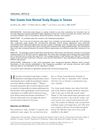Co-Occurrence of Monilethrix and Type 1 Diabetes Mellitus
January 2018
in “
Indian dermatology online journal
”
TLDR The girl has both monilethrix and Type 1 diabetes, but no link between the two conditions is known.
In 2018, a case study was conducted on a 14-year-old girl with type I diabetes mellitus (DM) who had sparse hair since birth, which gradually became denser. She was diagnosed with monilethrix, a condition characterized by hair shaft abnormalities, and type I DM. Her treatment included topical minoxidil 5% and multivitamins, which led to slight improvement. Monilethrix is believed to be caused by a hair keratin mutation, with the most common being the E413K mutation in hHb6. The condition mainly affects scalp hair, but can also affect eyelashes, eyebrows, and body hair. No previous association had been found between monilethrix and type 1 DM, suggesting that further studies are needed to confirm any potential link. The course and outcome of monilethrix is variable and unpredictable, with some cases showing partial or complete remission with age.



